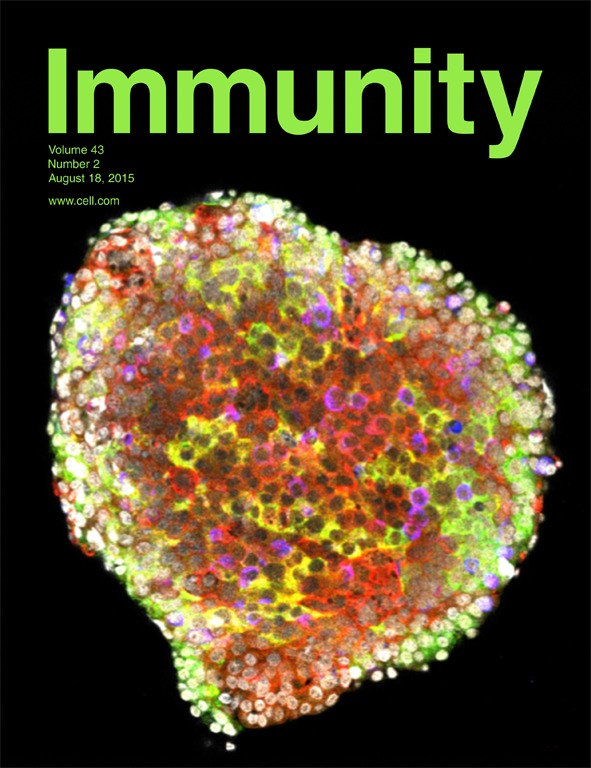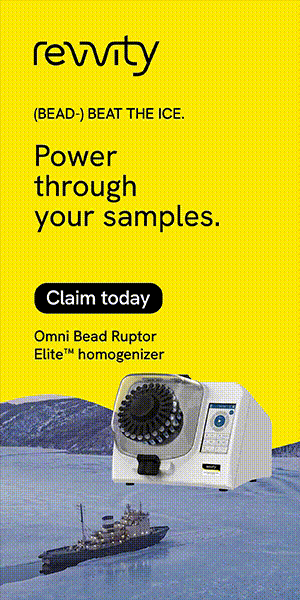- Submit a Protocol
- Receive Our Alerts
- Log in
- /
- Sign up
- My Bio Page
- Edit My Profile
- Change Password
- Log Out
- EN
- EN - English
- CN - 中文
- Protocols
- Articles and Issues
- For Authors
- About
- Become a Reviewer
- EN - English
- CN - 中文
- Home
- Protocols
- Articles and Issues
- For Authors
- About
- Become a Reviewer
House Dust Mite Extract and Cytokine Instillation of Mouse Airways and Subsequent Cellular Analysis
Published: Vol 6, Iss 14, Jul 20, 2016 DOI: 10.21769/BioProtoc.1875 Views: 13519
Reviewed by: Ivan ZanoniMeenal SinhaMario M. Zaiss

Protocol Collections
Comprehensive collections of detailed, peer-reviewed protocols focusing on specific topics
Related protocols
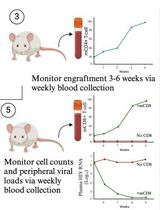
A Participant-Derived Xenograft Mouse Model to Decode Autologous Mechanisms of HIV Control and Evaluate Immunotherapies
Emma Falling Iversen [...] R. Brad Jones
Apr 5, 2025 2422 Views
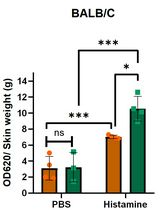
Analysis of Vascular Permeability by a Modified Miles Assay
Hilda Vargas-Robles [...] Michael Schnoor
Apr 5, 2025 2436 Views
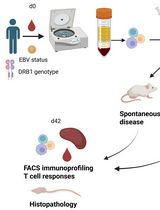
PBMC-Humanized Mouse Model for Multiple Sclerosis: Studying Immune Changes and CNS Involvement
Anastasia Dagkonaki [...] Lesley Probert
May 20, 2025 3812 Views
Abstract
Asthma is a complex disease of the airways primarily mediated by T helper 2 cells and innate lymphoid type 2 cells (Licona et al.,2013). Mice do not develop spontaneous asthma and therefore models have been developed for the assessment of key processes that underlie human pathology (Nial et al.,2008). Exposure to House Dust Mite (HDM) extract induces many key features of acute airway inflammation including elevated IgE levels, eosinophilia, goblet cell metaplasia, epithelial hypertrophy and airway hyperresponsiveness (AHR) in response to methacholine (Hammad et al., 2009; Dullaers et al., 2012; Coquet et al., 2015). The exact dose and duration of exposure to HDM can affect the type and extent of inflammation. In our case, we start with a low sensitizing dose that is increased on challenge, while others use differing schedules or a higher antigen concentration during sensitization of mice (Hondowicz et al., 2016; Trompette et al., 2014; Zaiss et al., 2015). We believe that using a low sensitizing dose more accurately separates the primary and secondary immune responses and reduces the possibility that HDM given during sensitization continues to fuel the immune response during challenge (Coquet et al., 2015; Plantinga et al., 2013). Here, we outline in text, pictures and video how to administer HDM extracts or cytokines via the intranasal route and briefly touch upon the subsequent analysis of inflammation in the airways [covered otherwise in ( Han et al., 2013)].
Keywords: HDMMaterials and Reagents
- 1.5 ml Eppendorf tube (Sarstedt, catalog number: 72.269.001 )
- 100 μM Filter (BD, catalog number: 352360 )
Note: Currently, it is “Corning, FalconTM, catalog number: 352360”. - Sterile pipette tips (Corning, catalog number: 4804 )
- 23 Gauge (G) sterile needle (BD, catalog number: 300800 )
- Polyethylene tubing PE-10 (BD, IntramedicTM, catalog number: 427401 )
- 1 ml syringe (BD, catalog number: 309659 )
- 15 ml screw cap tube conical (Corning, FalconTM, catalog number: 352096 )
- 50 ml screw cap tube conical (Corning, FalconTM, catalog number: 352070 )
- Soft wood/styrofoam board
- Mice
Note: We typically utilize C57BL/6 mice of at least 4 weeks of age. Either sex can be used although it is best not to mix genders in a particular experiment. - Isoflurane (Baxter, catalog number: KDG9623 )
- House Dust Mite (HDM) extract (Greer Laboratories, catalog number: XPB70D3A2.5 )
- 1x Dulbecco’s phosphate buffered saline (DPBS) (Sigma-Aldrich, catalog number: D8537 )
- Ethanol
- Recombinant cytokines [e.g., rIL-21 (gifted by Zymogenetics); rIL-25 (Biolegend, catalog number: 587302 ) or IL-33 (Biolegend, catalog number: 580502 )]
- Fetal calf serum (FCS), heat inactivated (Sigma-Aldrich, catalog number: F4135 )
- Trypan blue (Sigma-Aldrich, catalog number: 93595 )
- Red blood cell lysis buffer (Sigma-Aldrich, catalog number: R7757 )
Equipment
- Laminar flow hood
- Rodent anesthesia system [e.g., Univentor 400 Anesthesia Unit or Univentor 410 Anesthesia unit (Univentor, catalog number: 8323101 )]
- Pipette p200 (Sigma-Aldrich, catalog number: Z678333 )
- Spray bottle with 70% ethanol (Sigma-Aldrich, catalog number: Z560847 )
- Surgical scissors (e.g., Sigma-Aldrich, catalog number: Z265969 )
- Surgical Thread 4-0 (0.17 mm), sterile (e.g., Agnthos, catalog number: 14757 )
- Stainless steel forceps (e.g., Sigma-Aldrich, catalog number: Z168785 )
- Hemocytometer
- Centrifuge [e.g., Hettich Rotina 420R (Sigma-Aldrich, catalog number: Z723630 )]

Figure 1. Anesthesia setup. A. Mice should be anesthetized by isoflurane with the rate of breathing carefully observed to ensure a sufficient degree of anesthesia without being too light or too deep. B. Example of anesthesia system in this case is the Univentor 400 with air flow set to 388 ml/min and Isoflurane concentration of 3.8%.
Procedure
Note: All experiments using mice should be approved by the relevant animal ethics committee in accordance with both national and international guidelines.
- Allergen sensitization (Day 0)
- Freshly prepare a solution of HDM extract in DPBS at a concentration of 1 μg per 40 μl of DPBS per mouse (Figure 2 shows the schedule of administration).
Note: Sterile DPBS and good sterile technique in a tissue culture laminar flow hood are sufficient to reconstitute HDM extracts. No filtration of the solution is performed.
Figure 2. Schematic of HDM induced airway inflammation
- Anesthetize the mouse taking care to ensure the breathing rate is normal, as breathing that is either too shallow or too deep will prevent efficient uptake of HDM solution (see Video 1). A good depth of breathing should be regular and smooth [approx. 1 breath per second (see Video 2)]. At our facility, we use a Univentor 400 with airflow at 380-400 ml/min and an isoflurane concentration of between 3.6-4.0% depending on the size of the mouse (Figure 1). Typically, only 1-2 mice are anesthetized simultaneously. When mice are not anesthetized enough, you will notice that the mice will wake up too quickly, be moving their legs and fail to inhale all 40 μl. When mice are too deeply anesthetized, you will notice that their breathing rate is slow, but that they take very deep breaths (gasps). Typically, this will result in bubbles being blown when trying to administer your volume.Video 1. Intranasal administration of HDMVideo 2. Correct depth of anesthesia
- Hold the mouse gently on the backside of the neck (a very loose scruff) so that the head is up and the rear legs are facing down. Administer 40 μl of 1 μg HDM solution into the nostrils for each sensitized mouse (or DPBS alone for control mice) with care taken to ensure the uptake of the whole volume.
- After uptake, keep the mouse in an upright position for around 5 sec and check to ensure the mouse breathes normally.
- The mouse can be returned to its housing cage and left in a semi-upright position to recover from anesthesia.
- Freshly prepare a solution of HDM extract in DPBS at a concentration of 1 μg per 40 μl of DPBS per mouse (Figure 2 shows the schedule of administration).
- Allergen challenge (Days 7-11)
- Freshly prepare a solution of HDM extract in DPBS at a concentration of 10 μg per 40 μl per mouse.
- Anesthetize the mouse and administer HDM as described above using 10 μg HDM in a volume of 40 μl per mouse.
- Following this procedure, mice are challenged with HDM on Day 7, 8, 9, 10 and 11 post sensitization.
- Freshly prepare a solution of HDM extract in DPBS at a concentration of 10 μg per 40 μl per mouse.
- Cytokine inhalation
- Freshly prepare the particular cytokine at the desired concentration in a volume of 40 μl DPBS per mouse. As is the case with HDM, sterile DPBS and good sterile technique are important at this step. The precise concentration will vary with each cytokine and the response wishing to be studied. Recombinant cytokines such as IL-25 and IL-33 seem to produce robust responses even at low doses (ng range), whereas IL-21 will elicit responses at a higher dose (μg range). Figure 3 shows the schedule for a previous cytokine inhalation protocol use in Coquet et al., 2015, although others exist that may better suit your own research. Other cytokine inhalation protocols are also common (Willart et al., 2012; Kayamuro et al., 2010; Hiromura et al., 2007).

Figure 3. Schematic of cytokine inhalation
- Anesthetize the mouse taking care to ensure the breathing rate is normal, as breathing that is either too shallow or too deep will prevent efficient uptake of the cytokine solution.
- Administer into the nostrils of each mouse as described with HDM extract.
- This challenge can be repeated for 3 days with mice euthanized 24 h after the last challenge and tissues collected.
- Freshly prepare the particular cytokine at the desired concentration in a volume of 40 μl DPBS per mouse. As is the case with HDM, sterile DPBS and good sterile technique are important at this step. The precise concentration will vary with each cytokine and the response wishing to be studied. Recombinant cytokines such as IL-25 and IL-33 seem to produce robust responses even at low doses (ng range), whereas IL-21 will elicit responses at a higher dose (μg range). Figure 3 shows the schedule for a previous cytokine inhalation protocol use in Coquet et al., 2015, although others exist that may better suit your own research. Other cytokine inhalation protocols are also common (Willart et al., 2012; Kayamuro et al., 2010; Hiromura et al., 2007).
- Bronchoalveolar lavage (BAL) (D15 with HDM or D3 following cytokine inhalation)
Note: A similar protocol by Han and Ziegler is also available although some details do vary to that described below (10). We provide a video of the lavage for instructional purposes (see Video 3).Video 3. Isolation of airway cells by bronchial alveolar lavage
Note: Mice should not be sacrificed by cervical dislocation as this method can damage the trachea resulting in poor lavage of airways. Moreover, it can also lead to bleeding around the trachea.- Prepare the needle to be inserted into the trachea by attaching Polyethylene PE-10 tubing so that the tubing extends from the bevel point of the needle by approximately 3 mm. Ensure there are no sharp edges where the tubing has been cut (Figure 4A). Fill a syringe with 1 ml DPBS to be used for flushing out the lungs.
- Euthanize the mouse by CO2 asphyxiation or an approved anesthetic overdose protocol.
- Gently lay the mouse on its back, on a soft wooden/styrofoam surface, stretch the limbs and fix each paw with a pin (Figure 4B).

Figure 4. Typical equipment required for isolation of cells by lavage. A. Example of equipment used to carry out BAL extraction. 23 G needle has PE-10 plastic tubing attached extending approximately 3 mm from the bevel point of the needle. B. The mouse should be pinned by each limb and fur wet with 70% ethanol. - Wet the fur with 70% ethanol and make an incision with scissors at the base of the rib cage. Continue cutting the skin to the base of the jaw taking care not to rupture any of blood vessels found in the neck (Figure 5A).
- Separate the skin from the neck muscles and pin back to expose the neck.
- Using tweezers pull the surrounding salivary glands and muscles lining the trachea taking care not to damage the trachea itself (Figure 5B).

Figure 5. Preparation of mouse prior to collection of lavage. A. Removal of the skin up to the jaw exposing the salivary glands and neck muscles, behind which lies the trachea. B. Neck muscles, both the sternocleidomastoids and those surrounding the trachea, are removed by pulling firmly with tweezers to reveal the trachea. Care should be taken not to damage the windpipe. - Once the trachea is exposed, the surgical thread (min. 4 cm in length) can be passed underneath the trachea with tweezers. Using both tweezers, a loose knot can be made by looping the thread on one of the tweezers followed by passing the other end of the thread through the newly formed loop.
Note: The knot also helps secure the needle in place throughout the lavage procedure. - A small incision is made in the trachea roughly 2/3 from where it enters the rib cage. Avoid completely severing the trachea, as this will cause difficulties in subsequent steps (see Video 3).
- With care, the needle with plastic tubing attached can be inserted into the trachea until resistance is felt (approximately 10-15 mm in). Be careful not to push it through the lung tissue itself. Tighten the knot by pulling the ends of the thread in opposite directions. This will seal the lung and prevent the flow of PBS out of the opening during flushing.
- Attach a 1 ml syringe pre-filled with 1ml DPBS to the needle inserted in the trachea. With minimal movement of the needle, the plunger can be moved down to wash the lungs and airways with DPBS. It is critical that the needle is held in position with the non-injecting hand so as to avoid lung puncture. Expansion and contraction of the lungs or rib cage should be observed as DPBS is inserted and removed. Around 80-90% of the initial volume should be recovered. This can be transferred to a 15 ml tube and the lungs flushed with a further 1 ml of DPBS. The number of flushes should be consistent between mice to ensure the accuracy of subsequent cell counts. Video 2 depicts the mouse with an open chest cavity, but this was only for instructional purposes and for viewers to observe the inflation of the lungs. The chest cavity can remain closed during lavage.
- Top up each BAL sample in a 15 ml tube to 6 ml with DPBS and spin down for 5 min at 300 x g at 4 °C.
Note: If cytokines or other soluble factors are to be detected by ELISA or Luminex based assays, it is best to separate the 1st and 2nd flushes of the airways. The 1st flush can be spun down for 5 min at 300 x g at 4 °C without the addition of any volume so as not to dilute the target proteins of interest. The supernatant can then be collected and stored at -20 °C and further analysis can be carried out on the cells. - Discard the supernatant and resuspend the pellet in either media or FACs buffer (DPBS/2% FCS) depending on the downstream application.
Note: Erythrocytes can be present in the BAL wash as a result of blood vessel rupture during the protocol or due to airway inflammation. Blood vessel rupture will lead to a dark red coloration of the BAL. In the case of overt airway inflammation leading to tissue damage, BAL can have a mild straw color that fades with subsequent lavages. In either case, erythrocytes should be eliminated using a hypotonic buffer prior to further steps. Hypotonic buffers can lead to degranulation in eosinophils so this should be considered when using such solutions. Consider exsanguination of mice through an incision at the inferior vena cava (IVC) prior to performing lavage to reduce erythrocyte contamination. - Cell number can be determined by haemocytometer using trypan blue to exclude dead cells. Typical numbers range from 2.5 x 105-2.0 x 106 cells per sample in inflamed lungs (Coquet et al.,2015). In naïve or PBS-treated lungs, very few cells (1-5 x 104) should be observed (Cates et al., 2004).
- Prepare the needle to be inserted into the trachea by attaching Polyethylene PE-10 tubing so that the tubing extends from the bevel point of the needle by approximately 3 mm. Ensure there are no sharp edges where the tubing has been cut (Figure 4A). Fill a syringe with 1 ml DPBS to be used for flushing out the lungs.
Representative data

Figure 6. Flow cytometry plots of cells isolated from BAL. BAL cells from C57Bl/6 mice were collected 4 days after the last HDM challenge. Representative FSC-A/SSC-A profiles from mice exposed to HDM or a naïve control are shown in A (HDM-exposed) and B (Naïve). The presence of eosinophils in the BAL can be defined as Siglec-F+CD11c- cells and alveolar macrophages as Siglec-F+CD11c+. The difference between inflamed BAL and naïve control is evident by the increased proportion of eosinophils (typically values range from 60-90%) in the former A and their almost complete absence in the latter B.
Notes
- The house dust mite model of asthma can give some variability, especially in terms of the numbers of eosinophils observed between mice, therefore it is wise to set up experiments with 5 or more mice per group, whenever possible. It is critical that the sensitization of mice on day 0 run smoothly, since mice that fail to be efficiently sensitized will not develop robust eosinophilic infiltration into the airways; our model relies on effective secondary adaptive immune responses. The number of flushes between animals must be kept constant to ensure comparable cell counts. Lysis of red blood cells in the case where blood is observed in the lavage fluid will help to minimize cell count errors.
- With regards to cytokine instillation, the type of immune response can be altered by the dose applied and more prolonged models of cytokine administration are also common.
Acknowledgments
The authors acknowledge the services of the MTC animal facility (Karolinska Institute, Sweden). This work was supported by a Swedish Research Council Young Investigator Grant and a grant from the Swedish Cancer Society. This protocol was adapted from Coquet et al., 2015.
References
- Cates, E. C., Fattouh, R., Wattie, J., Inman, M. D., Goncharova, S., Coyle, A. J., Gutierrez-Ramos, J. C. and Jordana, M. (2004). Intranasal exposure of mice to house dust mite elicits allergic airway inflammation via a GM-CSF-mediated mechanism. J Immunol 173(10): 6384-6392.
- Coquet, J. M., Schuijs, M. J., Smyth, M. J., Deswarte, K., Beyaert, R., Braun, H., Boon, L., Karlsson Hedestam, G. B., Nutt, S. L., Hammad, H. and Lambrecht, B. N. (2015). Interleukin-21-Producing CD4(+) T Cells Promote Type 2 Immunity to House Dust Mites. Immunity 43(2): 318-330.
- Dullaers, M., De, B. R., Ramadani, F., Gould, H.J., Gevaert, P., Lambrecht, B. N.(2012). The who, where, and when of IgE in allergic airway disease. Journal of Allergy and Clinical Immunology. 129(3):635-45.
- Hammad, H., Chieppa, M., Perros, F., Willart, M. A., Germain, R. N., Lambrecht, B. N.(2009). House dust mite allergen induces asthma via Toll-like receptor 4 triggering of airway structural cells. Nat Med 15(4):410-6.
- Han, H., Ziegler, S. F., Bronchoalveolar lavage and lung tissue digestion.(2013). Bio-protocol 3(16):e859.
- Hiromura, Y., Kishida, T., Nakano, H., Hama, T., Imanishi, J., Hisa, Y., Mazda, O. (2007). IL-21 administration into the nostril alleviates murine allergic rhinitis. The Journal of Immunology 179(10):7157-65.
- Hondowicz, B. D., An, D., Schenkel, J. M., Kim, K. S., Steach, H. R., Krishnamurty, A. T., Keitany, G. J., Garza, E. N., Fraser, K. A., Moon, J. J., Altemeier, W. A., Masopust, D. and Pepper, M. (2016). Interleukin-2-dependent allergen-specific tissue-resident memory cells drive asthma. Immunity 44(1): 155-166.
- Kayamuro, H., Yoshioka, Y., Abe, Y., Arita, S., Katayama, K., Nomura, T., Yoshikawa, T., Kubota-Koketsu, R., Ikuta, K., Okamoto, S., Mori, Y., Kunisawa, J., Kiyono, H., Itoh, N., Nagano, K., Kamada, H., Tsutsumi, Y., Tsunoda, S. (2010). Interleukin-1 family cytokines as mucosal vaccine adjuvants for induction of protective immunity against influenza virus. Journal of Virology 84(24):12703-12.
- Licona-Limon, P., Kim, L. K., Palm, N. W. and Flavell, R. A. (2013). TH2, allergy and group 2 innate lymphoid cells. Nat Immunol 14(6): 536-542.
- Nials, A. T. and Uddin, S. (2008). Mouse models of allergic asthma: acute and chronic allergen challenge. Dis Model Mech 1(4-5): 213-220.
- Plantinga, M., Guilliams, M., Vanheerswynghels, M., Deswarte, K., Branco-Madeira, F., Toussaint, W., Vanhoutte, L., Neyt, K., Killeen, N., Malissen, B., Hammad, H. and Lambrecht, B. N. (2013). Conventional and monocyte-derived CD11b(+) dendritic cells initiate and maintain T helper 2 cell-mediated immunity to house dust mite allergen. Immunity 38(2): 322-335.
- Trompette, A., Gollwitzer, E. S., Yadava, K., Sichelstiel, A. K., Sprenger, N., Ngom-Bru, C., Blanchard, C., Junt, T., Nicod, L. P., Harris, N. L. and Marsland, B. J. (2014). Gut microbiota metabolism of dietary fiber influences allergic airway disease and hematopoiesis. Nat Med 20(2): 159-166.
- Willart, M. A., Deswarte, K., Pouliot, P., Braun, H., Beyaert, R., Lambrecht, B. N. and Hammad, H. (2012). Interleukin-1alpha controls allergic sensitization to inhaled house dust mite via the epithelial release of GM-CSF and IL-33. J Exp Med 209(8): 1505-1517.
- Zaiss, M. M., Rapin, A., Lebon, L., Dubey, L. K., Mosconi, I., Sarter, K., Piersigilli, A., Menin, L., Walker, A. W., Rougemont, J., Paerewijck, O., Geldhof, P., McCoy, K.D., Macpherson, A.J., Croese, J., Giacomin, P.R., Loukas, A., Junt, T., Marsland, B. J., Harris, N. L. (2015). The Intestinal microbiota contributes to the ability of helminths to modulate allergic inflammation. Immunity 43(5):998-1010.
Article Information
Copyright
© 2016 The Authors; exclusive licensee Bio-protocol LLC.
How to cite
Tibbitt, C. and Coquet, J. M. (2016). House Dust Mite Extract and Cytokine Instillation of Mouse Airways and Subsequent Cellular Analysis. Bio-protocol 6(14): e1875. DOI: 10.21769/BioProtoc.1875.
Category
Immunology > Animal model > Mouse
Do you have any questions about this protocol?
Post your question to gather feedback from the community. We will also invite the authors of this article to respond.
Share
Bluesky
X
Copy link



